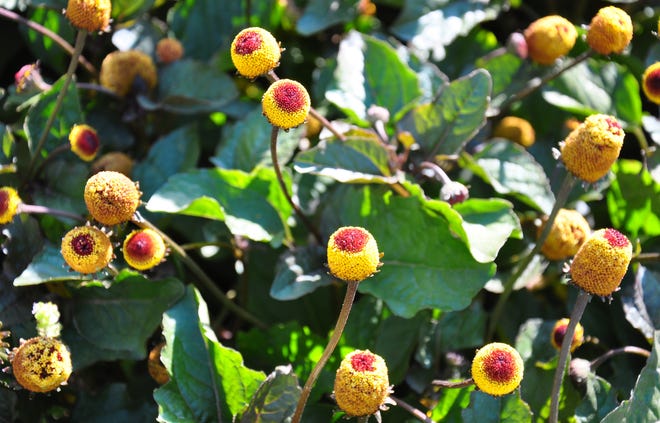CHARLES REYNOLDS: Got a toothache? There's a plant for that
Charles Reynolds
I have an acquaintance who dislikes the taste of beer but drinks it anyway because he likes ‘’the buzz.’’ A cheaper, different sort of sensation can be achieved simply by chewing the flower of a toothache plant. Also caused ‘’buzz button’’ and ‘’electric daisy,’’ this South American perennial grows about a foot tall and 2 feet wide in full or part-day sun. The species (Acmella oleracea) contains a chemical called spilanthol that’s released when the yellow-and-red, olive-shaped blossoms are chewed. The mouth-numbing effect is surprisingly pronounced and sometimes accompanied by excessive salivation — even drooling.
Of course gardeners are more interested in the plants’ appearance, with its bright and abundant flowers decorating shrubbery borders and containers.
The foliage of toothache plant also contains spilanthol, and a few shredded leaves added to salads are said to be flavorful rather than numbing. The species is tender and should be installed in sheltered locations. Propagation is by seeds sown on top of moist soil because sunlight is necessary for germination, which takes place within two weeks. Seeds available online.
Vastly larger than toothache plant is Hercules’ club, also called toothache tree. This cold-hardy native species (Zanthoxylum clava-hercules) ranges from a 10-foot shrub to a 25-foot tree. Part of the citrus family, the leaves, bark and twigs of Hercules’ club were chewed by native Americans and early settlers to dull the pain of toothaches and mouth sores. Extracts of the plant are still used as herbal remedies. That’s understandable because the species contains two alkaloids — one that causes tingling and mild numbing, and another that’s considered anti-bacterial.
A uniquely picturesque plant for the landscape, Hercules’ club features dark-green glossy and leathery leaves that emit a citrusy aroma when crushed. Most noticeable, though, are impressive prickles that almost cover the plant, particularly the trunk and main branches. This ferocious aspect is softened by clusters of greenish-white flowers in spring and the plant’s graceful and airy crown. Older specimens are especially ornamental, often displaying a gnarled appearance.
Unfortunately, Hercules’ club tends to sucker, forming colonies if left unchecked. Plants do well in sun or moderate shade. It’s a dioecious species, which means male and female specimens are necessary to produce fruit; they ripen in autumn, and each contains a single black seed. Propagate by transplanting rooted suckers or by seeds, which tend to have a low germination rate. Seeds — and occasionally plants — are available online.
Charles Reynolds, a Winter Haven resident, has an associate’s degree in horticulture and is a member of Garden Writers Association of America. He can be reached at ballroom16@aol.com

